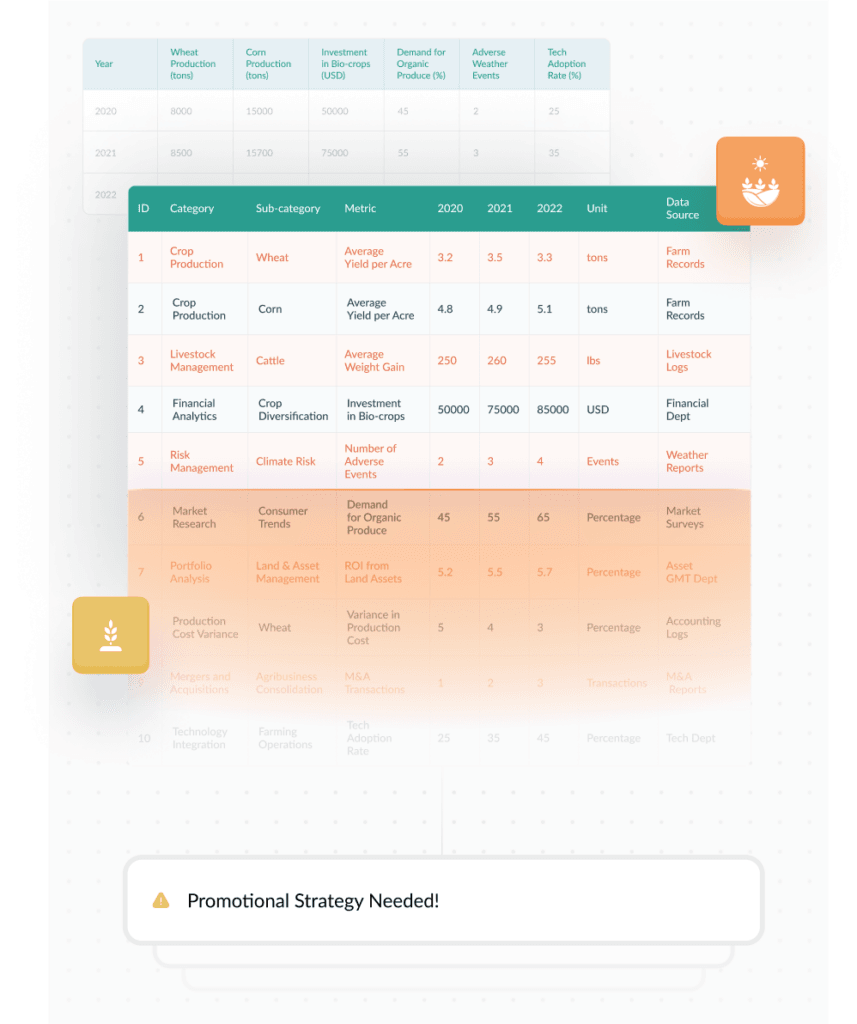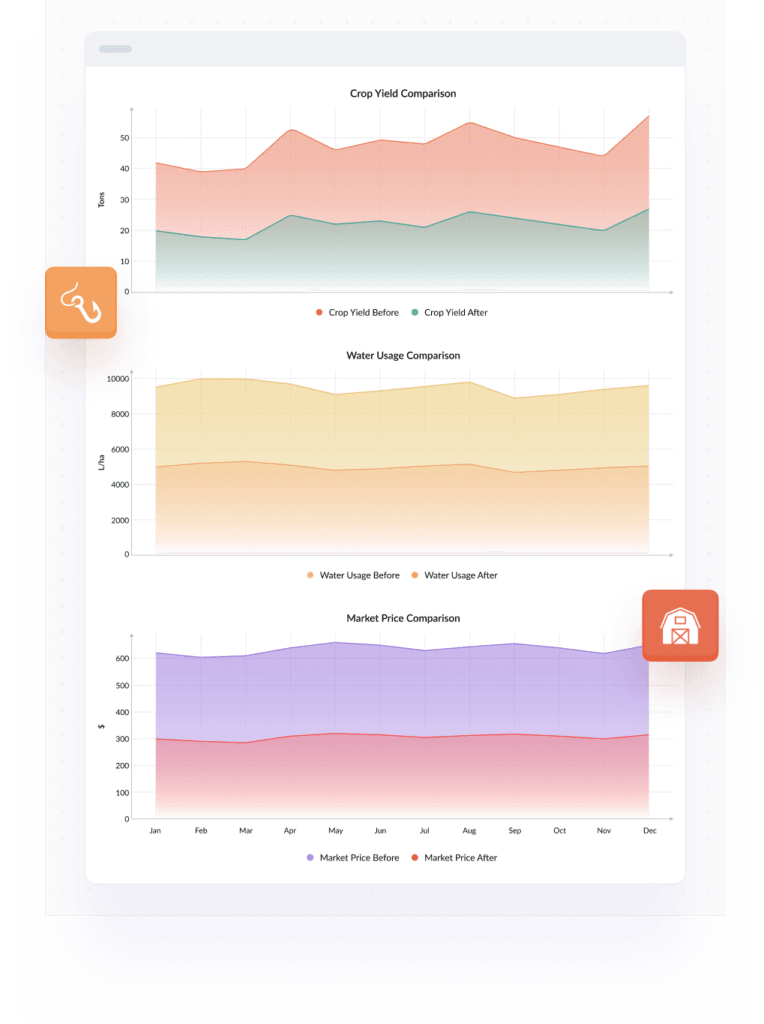Agriculture
Farming, Fishing, and Forestry

Financial & Capital Analytics
Crop Production: Analyze yield data and price trends across different crops, factoring in seasonal weather patterns and global demand shifts. Understand how these variables impact revenue forecasts and cost structures
Livestock Management: Evaluate the financial health of livestock operations by monitoring feed costs, livestock prices, and productivity rates. Consider the economic implications of animal health and biosecurity measures on overall profitability
Agribusiness Operations: Scrutinize the financial metrics of agribusiness entities, including cooperatives and agricultural processors. Assess the impact of supply chain efficiencies and raw material cost fluctuations on their financial stability
Land & Asset Management: Optimize asset portfolios by assessing the value and return on investment of agricultural land and equipment. Identify underperforming assets and explore opportunities for diversification, such as renewable energy installations on farm properties
Crop Diversification: Balance the portfolio of crop productions to mitigate risks associated with climate variability and market volatility. Implement financial strategies that support crop rotation and sustainable farming practices
Market Demand & Export Opportunities: Investigate fluctuations in global demand for agricultural products and identify emerging markets. Analyze export trends and barriers to help agribusinesses capitalize on international opportunities
Consumer Trends in Food Consumption: Conduct in-depth research into consumer preferences for organic and locally sourced foods. Understand how these trends affect pricing strategies and market positioning for agricultural products
Cost of Production Analysis: Develop financial models that estimate the cost of production for various crops and livestock, incorporating variables such as input costs, labor, and technology use. Use these models to project future profitability and guide pricing decisions
Revenue Forecasting for Agribusiness: Create tailored financial projections for agribusiness companies, considering factors like commodity prices, government subsidies, and operational improvements. Analyze the financial impact of agricultural policy changes and trade agreements
Capital Structure Optimization: Determine the optimal mix of debt, equity, and grants (such as government agricultural supports) to fund agricultural operations. Strategize on financing for new agricultural technology and infrastructure developments
Financial Risk Management in Agriculture: Identify and mitigate financial risks associated with commodity price volatility, interest rate fluctuations, and credit availability. Employ derivative instruments like futures and options to hedge financial exposures
Seasonal Variance Tracking: Monitor and analyze financial variances caused by seasonal production shifts and market conditions. Adjust operational and financial strategies to optimize performance throughout the agricultural cycle
Production Cost Variance: Identify discrepancies between projected and actual production costs. Investigate variances to refine budgeting and improve financial control mechanisms in agricultural operations
Climate Risk Assessment: Evaluate the financial implications of climate change on agricultural outputs. Develop strategies to mitigate risks associated with extreme weather events and changing climatic conditions
Market Price Fluctuation: Assess the impact of volatile market prices on the financial stability of farming operations. Implement financial safeguards to protect against sudden drops in commodity prices
Agribusiness Consolidation: Analyze potential M&A opportunities within the agriculture sector to enhance scale, improve supply chain control, or enter new markets. Consider synergies and integration challenges in consolidating farming operations or agribusiness firms
Technology Integration: Evaluate the financial and operational benefits of acquiring agri-tech companies. Assess how advancements in agricultural technology can be leveraged to improve efficiency and financial performance in traditional farming operations
Business Intelligence
Summarize production levels, crop yields, and resource usage to assess agricultural efficiency and sustainability
Diagnose causes of yield variations or production inefficiencies by examining soil health data, weather patterns, and cultivation practices
Forecast future crop yields or predict the impact of climate change on production using historical data combined with environmental models
Recommend crop rotation strategies or resource allocation adjustments to optimize yields and minimize environmental impact based on predictive insights
Integrate diverse data sources, including satellite imagery, market trends, and ecological studies, to infer optimal farming practices and prepare for future agricultural conditions


Streamlining
Map out the entire agricultural cycle from planting to harvest, including supply chain logistics for inputs like seeds and fertilizers. Identify inefficiencies such as overlapping duties or underutilized resources
Introduce precision farming technologies, such as GPS-guided tractors, automated feed systems in aquaculture and forestry, and drone monitoring to optimize resource use and improve yields
Use metrics such as crop yield rates, soil health, water usage, and market prices to monitor performance and adapt practices to improve efficiency and profitability
Consolidate operations where feasible, such as sharing machinery pools among smaller farms or integrating aquaculture systems with crop production to optimize space and resources
Standardize processes for planting, harvesting, pest management, and safety procedures to ensure consistent quality and compliance with regulatory standards
Set up regular feedback mechanisms from field workers, agronomists, and market analysts to refine operations and respond quickly to market demands or environmental changes
Evaluate the impact of streamlining efforts on productivity, cost efficiency, and environmental sustainability. Adapt strategies based on these insights to optimize resource use and market response
